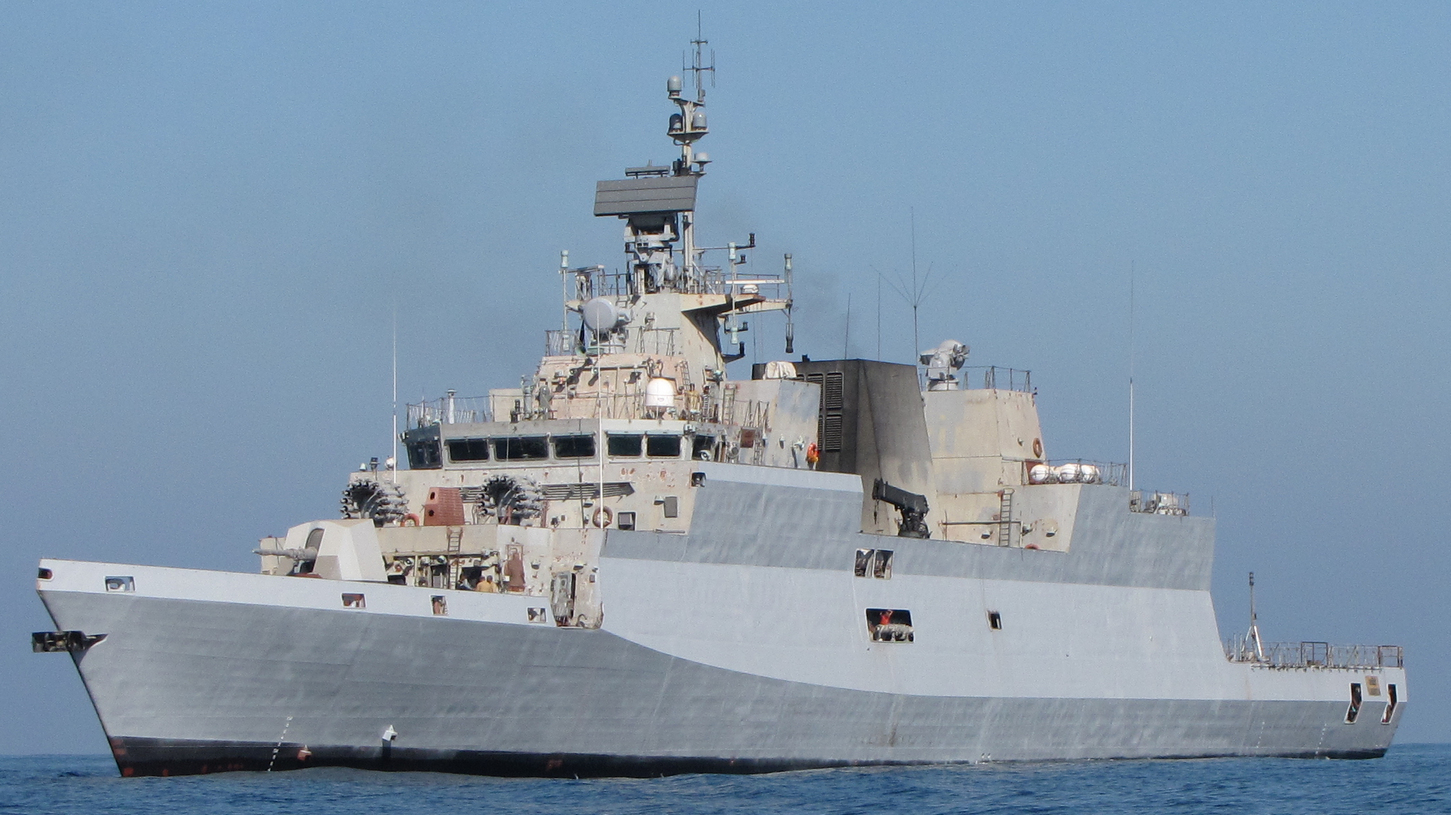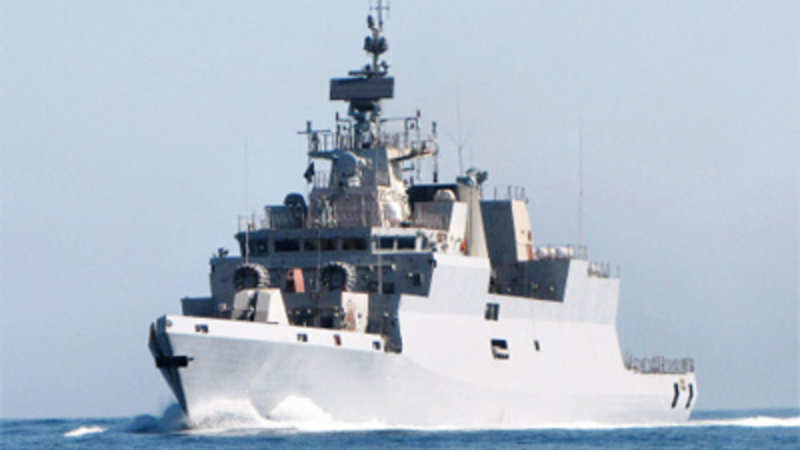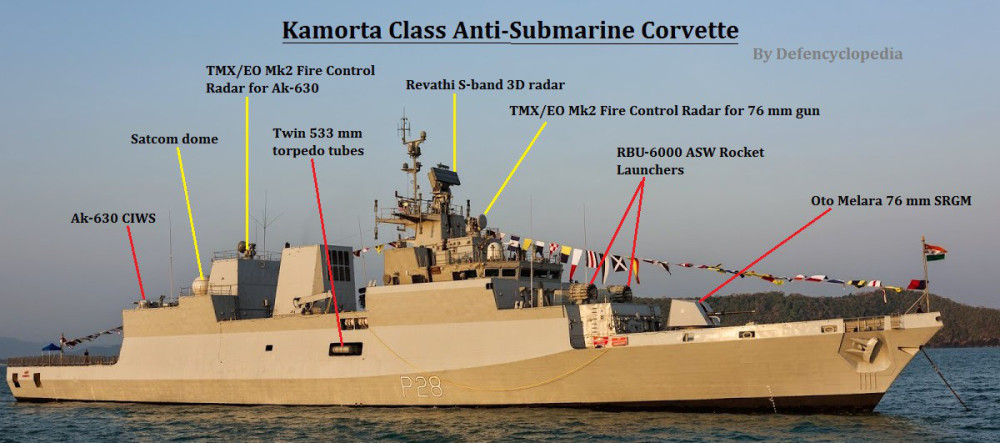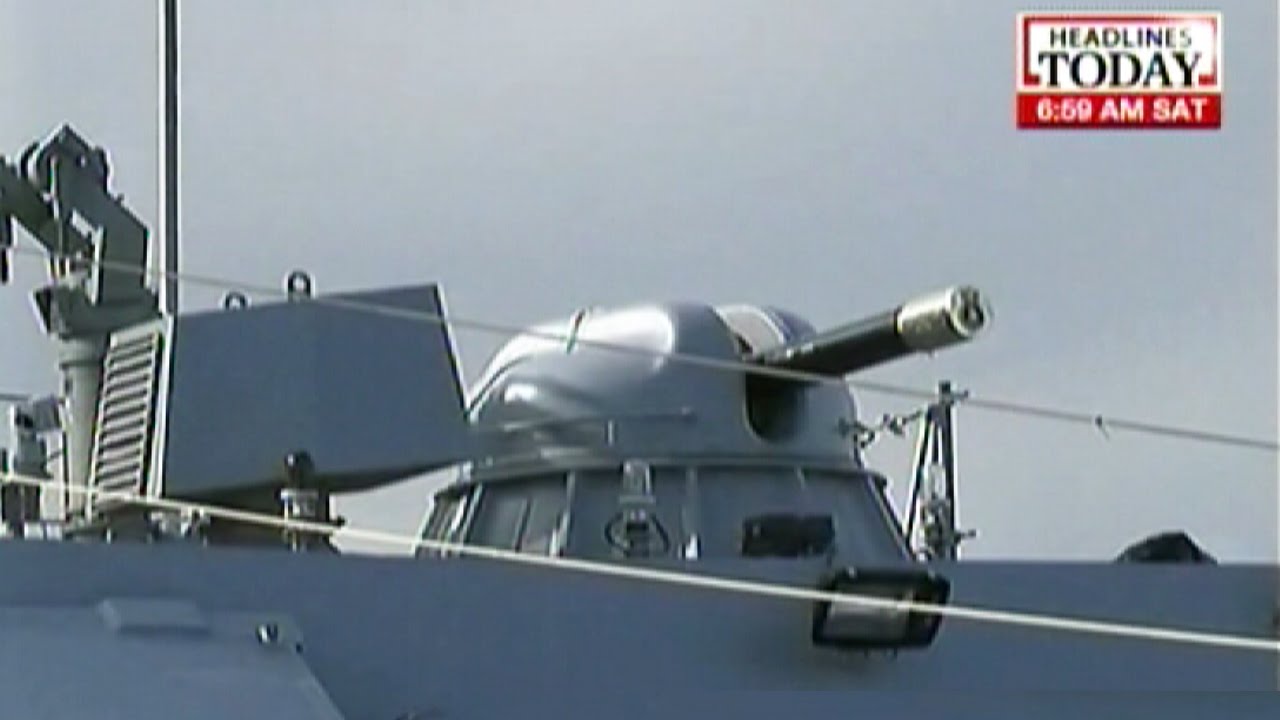Kamorta Class ASW Corvettes
- Thread starter Daredevil
- Start date
More options
Who Replied?- Joined
- Sep 22, 2012
- Messages
- 3,332
- Likes
- 5,426
Seriously..What is this issue with IN when it comes to Docking ships they screw time and again ...is it just fatigue of over workload are some serious lethargy in handling the situations ..
Watch the Video it was a close call but no contact or collision . watch from 0.26 to 0.40 the photo is morphedThat ain't a collision pic.....
Last edited:
captscooby81
New Member
- Joined
- Dec 25, 2016
- Messages
- 7,371
- Likes
- 27,670
Thanks for the update ..Not sure why the col posted this and said there is damage to the ship and how bad it is need to be assessed ...I just pray that nothing like this happened i am more than happy to see our ships without a scratch ...
Watch the Video it was a close call but no contact or collision . watch from 0.26 to 0.40 the photo is morphed
- Joined
- May 26, 2010
- Messages
- 31,122
- Likes
- 41,041

Corvette in action, using its main gun which is 76mm rapid firing gun ..
- Joined
- May 26, 2010
- Messages
- 31,122
- Likes
- 41,041


P-28 exhaust usually get dark, Due to such reason the exhaust is painted in black ..
Though, this is not seen in P-29,30,31 ..
- Joined
- May 26, 2010
- Messages
- 31,122
- Likes
- 41,041

P-28, Commissioned in 23 August 2014

P-29, Commissioned in 7 January 2016

P-30, Commissioned in 16 October 2017

The overall length of the Kamorta-class corvettes is 109 m (358 ft), and the beam spans 13.7 m (45 ft). The ships displace about 2,500 tonnes (2,500 long tons; 2,800 short tons) at standard load and 3,500 tonnes (3,400 long tons; 3,900 short tons) when fully loaded. Each ship compliments 180 sailors and 13 officers.P-31, Commissioned in Before end 2017
- Joined
- May 26, 2010
- Messages
- 31,122
- Likes
- 41,041




These ships have 90% Indian contents besides 100% Indian design ..
- Joined
- May 26, 2010
- Messages
- 31,122
- Likes
- 41,041



Some internal pictures of the ship ..
Kalki_2018
New Member
- Joined
- Jun 28, 2017
- Messages
- 720
- Likes
- 1,253
Do they have any missiles yet? Barak-1's at least.
So, the Kamorta class is a class of ASW frigates having comprehensive anti sub warfare capability but without any anti air capability, thus, taking into consideration its strengths and weaknesses, how exactly does the IN plan to employ these during peace and during war.
Eg. Will these be used as part of the CBG(this seems improbable due to their lack of AAW capability)
Will these be used closer to the coast under the protection of land based aircraft? etc.
What are the future possibilities of the Kamorta class deploy Medium uuv's or usv's (i consider these to be force multipliers especially with respect to sub detection)
Eg. Will these be used as part of the CBG(this seems improbable due to their lack of AAW capability)
Will these be used closer to the coast under the protection of land based aircraft? etc.
What are the future possibilities of the Kamorta class deploy Medium uuv's or usv's (i consider these to be force multipliers especially with respect to sub detection)
'' Researches in remote control started in 60's at Central Research Institute for Automatics and Hydraulics (Moscow). "A wire line was adopted basing on simultaneous doubled paying out of cable from two spools located in torpedo and towed by a submarine. Such telecontrol system was applied in SET-53M type torpedo commissioned in 1969 under the index TEST-68. In 1971 torpedo TEST-71 was designed on the basis of more advanced torpedo SET-65; then – torpedo TEST-71M and helicopter-based remote-controlled torpedo VTT-1 on the basis of torpedo AT-1" ("60 years of CRI Gidropribor", St. Petersburg, 2003).
In contrast to western telecontrol systems providing both directional and depth control of several torpedoes for maximum consideration of hydrology, decreasing of torpedo's noise, and alteration of target class (for example, while submarine's "dolphin jump" surfacing), telecontrol system of our Projects 641B and 877 diesel electric subs provided only horizontal guidance of only one torpedo. Submarine-towed telecontrol spool is still used. Influence of water currents on torpedo's speed leads to spool curling and wire breakage. Application of long conducting ropes to decrease this effect excludes use of telecontrol at shallow depths and makes multiple launches impossible.
Late 60's Western designers developed umbilical telecontrol spool; after launch, it remained on breech door of torpedo tube. Cable slippage was provided by protective "hose" to compensate submarine's post-launch maneuvering. Umbilical telecontrol enabled to increase reliability of cable connection, reduce limitations in speed and maneuvers, and ensure multiple launches including those at shallow depths. Consequently, torpedo weapons became more effective, and distances between launch site and targets were significantly increased.
In 70's Soviet Union also had everything to adopt umbilical spools; however, the Navy hindered that innovation. The necessity of post-launch removing a spool and a "hose" from torpedo tube required manual operations. Navy Technical Development Plan involved automatic reload of torpedo tubes which was possible only with towed spool. So, the Navy rejected "hose" telecontrol systems; moreover, it was widely believed that "we don't need it", since our subs and torpedoes were less silent and so forth. USET-80, basic torpedo of 3rd generation nuclear submarines had never obtained homing system prescribed in Technical Development Plan.
By the way, in real conditions even brief telecontrol considerably increases effectiveness of torpedo launch against submarine; moreover, successful launch against surface ships performing anti-torpedo zigzag maneuvers at a distance over 11-13 km is possible only with telecontrol. The main thing is that up to mid-80's telecontrol remained the only effective interference resistance method in conditions of high sonar countermeasure. Till early 80's there were no homing systems with required interference resistance worldwide. So to provide effective fire, the US Navy has been using telecontrol as indispensable condition since 50's; their surface ships are equipped with broad range of ASW means to maintain capability of multiple attacks upon submarines.
All Western heavy torpedoes and even new Chinese torpedoes use umbilical telecontrol. Towed spool applied in our torpedoes is a 50-year old rudiment. In fact, this places Russian subs in the crosshairs of enemy's weapons having much more effective firing range.
The situation is that, for example, none of Russian torpedoes presented at international defense show IMDS-2009 had umbilical telecontrol spool, even the most advanced UGST! Only towed spools... ''
This is an extract from an article i found online, it discusses the flaws of Russian torpedoes. Since a majority of our torpedoes are Russian, are our torpedoes too limited by the same problems?
If our torpedoes are limited by the same problem, what procedures/tactics are used to minimise this handicap?
Also, are the Ship and sub launched versions of the varunastra limited by the same problem?
Article source
http://rusnavy.com/science/weapons/underseaweapon/index.php?print=Y&ei=i2n01bwm&lc=en-IN&s=1&m=681&host=www.google.co.in&ts=1475580932&sig=AF9Nedntole3bdSEbMPSNWWXrk7x8EwIPA
In contrast to western telecontrol systems providing both directional and depth control of several torpedoes for maximum consideration of hydrology, decreasing of torpedo's noise, and alteration of target class (for example, while submarine's "dolphin jump" surfacing), telecontrol system of our Projects 641B and 877 diesel electric subs provided only horizontal guidance of only one torpedo. Submarine-towed telecontrol spool is still used. Influence of water currents on torpedo's speed leads to spool curling and wire breakage. Application of long conducting ropes to decrease this effect excludes use of telecontrol at shallow depths and makes multiple launches impossible.
Late 60's Western designers developed umbilical telecontrol spool; after launch, it remained on breech door of torpedo tube. Cable slippage was provided by protective "hose" to compensate submarine's post-launch maneuvering. Umbilical telecontrol enabled to increase reliability of cable connection, reduce limitations in speed and maneuvers, and ensure multiple launches including those at shallow depths. Consequently, torpedo weapons became more effective, and distances between launch site and targets were significantly increased.
In 70's Soviet Union also had everything to adopt umbilical spools; however, the Navy hindered that innovation. The necessity of post-launch removing a spool and a "hose" from torpedo tube required manual operations. Navy Technical Development Plan involved automatic reload of torpedo tubes which was possible only with towed spool. So, the Navy rejected "hose" telecontrol systems; moreover, it was widely believed that "we don't need it", since our subs and torpedoes were less silent and so forth. USET-80, basic torpedo of 3rd generation nuclear submarines had never obtained homing system prescribed in Technical Development Plan.
By the way, in real conditions even brief telecontrol considerably increases effectiveness of torpedo launch against submarine; moreover, successful launch against surface ships performing anti-torpedo zigzag maneuvers at a distance over 11-13 km is possible only with telecontrol. The main thing is that up to mid-80's telecontrol remained the only effective interference resistance method in conditions of high sonar countermeasure. Till early 80's there were no homing systems with required interference resistance worldwide. So to provide effective fire, the US Navy has been using telecontrol as indispensable condition since 50's; their surface ships are equipped with broad range of ASW means to maintain capability of multiple attacks upon submarines.
All Western heavy torpedoes and even new Chinese torpedoes use umbilical telecontrol. Towed spool applied in our torpedoes is a 50-year old rudiment. In fact, this places Russian subs in the crosshairs of enemy's weapons having much more effective firing range.
The situation is that, for example, none of Russian torpedoes presented at international defense show IMDS-2009 had umbilical telecontrol spool, even the most advanced UGST! Only towed spools... ''
This is an extract from an article i found online, it discusses the flaws of Russian torpedoes. Since a majority of our torpedoes are Russian, are our torpedoes too limited by the same problems?
If our torpedoes are limited by the same problem, what procedures/tactics are used to minimise this handicap?
Also, are the Ship and sub launched versions of the varunastra limited by the same problem?
Article source
http://rusnavy.com/science/weapons/underseaweapon/index.php?print=Y&ei=i2n01bwm&lc=en-IN&s=1&m=681&host=www.google.co.in&ts=1475580932&sig=AF9Nedntole3bdSEbMPSNWWXrk7x8EwIPA
S.Balaji
New Member
- Joined
- Sep 28, 2015
- Messages
- 131
- Likes
- 761
Had visited kamrota while it was berthed at Chennai harbour, it had 2 rail launch UAV modules on its Heli deck....wasn't able to get the name of the system ....but the sailors said it was a indigenous system......so they are using UAVs for airborne surveillance over sea....it has soft kill missile counter measure suite Kavach apart from SRGM AK630 weapons system against surface/air targetsWhat are the future possibilities of the Kamorta class deploy Medium uuv's or usv's (i consider these to be force multipliers especially with respect to sub detection)
WolfPack86
New Member
- Joined
- Oct 20, 2015
- Messages
- 10,571
- Likes
- 16,993





INS Kamorta asw corvettes.
- Joined
- Nov 23, 2017
- Messages
- 6,239
- Likes
- 26,077
What's the update on Project 28A? ..all Kamorta class "Corvettes" been completed.^^ Whats the point of copy pasting photo in each thread?
At 3300 ton of small frigates they should have put in some SAMs atleast, or mine-clearing equipment note that the deal to buy 24 Mine-countermeasure vessel is fucked.
| Thread starter | Similar threads | Forum | Replies | Date |
|---|---|---|---|---|
| W | Amur 950 class submarine | Naval Warfare | 0 | |
|
|
Project 17B class Frigates | Indian Navy | 11 | |
|
|
Do Chinese Yuan Wang Class Spy ships Pose a Threat to india | Naval Warfare | 6 | |
| W | DRDO DEVELOPING SUBMARINE-LAUNCHED CRUISE MISSILE FOR P75 KALVARI CLASS SUBMARINES | Indian Navy | 0 |
Articles
-
India Strikes Back: Operation Snow Leopard - Part 1
- mist_consecutive
- Replies: 9
-
Aftermath Galwan : Who holds the fort ?
- mist_consecutive
- Replies: 33
-
The Terrible Cost of Presidential Racism(Nixon & Kissinger towards India).
- ezsasa
- Replies: 40
-
Modern BVR Air Combat - Part 2
- mist_consecutive
- Replies: 22
-
Civil & Military Bureaucracy and related discussions
- daya
- Replies: 32
